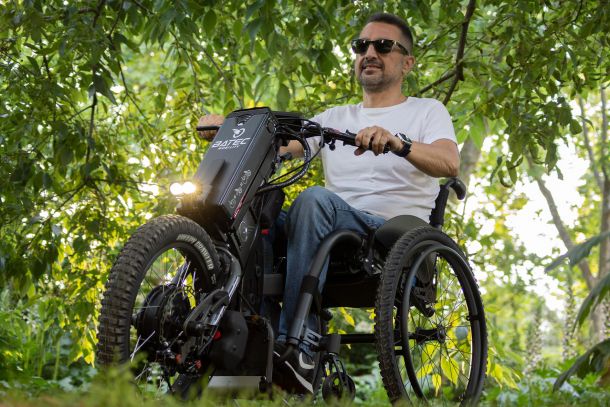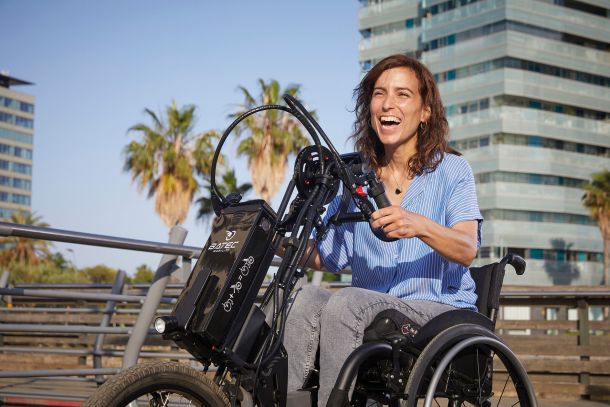
What is a traction unit for wheelchairs?
A traction unit for wheelchairs, often referred to as a handbike, is an aid that is attached to the wheelchair via a bracket and propelled by a motorized drive wheel. It is basically a towing wheel that is equipped with a handlebar including accelerator, brake and other functions, similar to a motorcycle. The bracket into which the traction unit is locked enables a firm and secure connection to the wheelchair. A pretensioning traction device is particularly helpful for people with limited mobility such as paraplegics, hemiplegics or quadriplegics. It transforms the wheelchair into a practical wheelchair bike, which makes wheelchair propulsion considerably easier.
Advantages of a wheelchair traction unit
A wheelchair hoist offers several advantages for the mobility and freedom of the user. It extends the range of movement and allows you to reach higher speeds. It promotes social integration as it increases the range of movement and thus facilitates access to different places. It is also an excellent alternative to the car, especially in urban areas.
Some models of wheelchair traction devices are lightweight, foldable and compact, which makes them particularly maneuverable. They are also capable of negotiating obstacles such as kerbs and inclines. Therefore, wheelchair tractors are a valuable tool for wheelchair users to improve their independence and quality of life.

Possible uses of a traction unit for wheelchairs
A traction unit for wheelchairs opens up numerous possibilities. Whether in the city or in the countryside, this useful aid enables you to overcome uneven paths and go on outings with your family or friends. With a wheelchair traction unit, you can even keep up with bicycles and cover long distances with ease.
It is also ideal for errands such as shopping. Equipped with a rucksack, you can complete your excursions and errands in comfort. It is important that the traction unit has STVO approval and has been tested by TÜV. So you can be sure that you are safe and legal on any road.

Selection criteria when purchasing a wheelchair traction device
Various factors play a role in the selection of a wheelchair traction device. The safety and reliability of the device come first. Technical data such as range and speed are also important. Pay attention to the features - additional functions can make use more convenient. The visual aspect should not be neglected either, as the traction unit can become a lifestyle product.
Good service from the manufacturer, which also guarantees easy installation, is another selection criterion. Make sure that the traction unit can also be approved for use on public roads, if you wish, and that suitable safety precautions can be taken for this.
Tips for using and caring for a traction unit for wheelchairs
The correct use and care of a traction unit for wheelchairs is crucial to extending its service life. Careful handling begins with detailed instruction in its use and careful reading of the operating instructions and the manufacturer's instructions. You should follow the instructions exactly and avoid overloading the appliance and using it improperly.
It is important to check the wearing parts regularly and have them replaced if necessary. Clean the traction unit with mild cleaners to prevent damage to the surface.
It is also important to observe the STVO rules and use an STVO kit when using the wheelchair traction unit on the road. Also wear a helmet for your personal safety.
Where you can purchase a wheelchair traction device
Many wheelchair drives, including traction devices, have an official aid number. These aids can therefore be covered by health insurance. However, this can also depend heavily on the individual situation of the applicant and the specific guidelines of the health insurance company. It is advisable to try out the official route via the health insurance company before considering a private purchase.
The first step before applying for an aid is a personal and individual consultation. Many manufacturers also offer an on-site service and will visit you at home. You should try out the various traction devices in a familiar environment and select the model that best meets your requirements and needs.
To apply for the selected wheelchair drive, you will then need to make an appointment with your doctor. Your doctor will check whether such an aid is necessary and, if necessary, issue you with a prescription. This prescription should always include the product name of the product that you have selected and already tested extensively.
You can then use this prescription to contact a medical supply store near you. They will contact the manufacturer of the traction device and also send a cost estimate to your health insurance company. As already mentioned, most wheelchair traction devices have an official aid number. The cost of the aid is therefore usually covered by your health insurance company. Once approval has been granted, the desired aid will be ordered and delivered to you as quickly as possible.
Some medical supply stores specialize in the sale and delivery of traction devices. You can find an overview of authorized dealers in your area here:

User experience stories
User reviews are a valuable source of information for potential customers. They offer insights into everyday life with a product that cannot be conveyed by mere product descriptions. User reports represent the wheelchair traction device authentically and offer an insight into personal experiences. They can also share useful tips and tricks that maximize the benefits of a traction device as a wheelchair drive.
You can find some user reports here:
Frequently asked questions about wheelchair traction devices (FAQs)
What factors determine whether a wheelchair traction device is covered by health insurance?
The assumption of costs for a wheelchair traction device by the health insurance company depends on various factors. Firstly, your state of health and the degree of your mobility impairment. The more severe your mobility impairment, the more likely it is that the costs will be covered. Secondly, whether the wheelchair traction device is medically necessary. If your doctor classifies it as a medical necessity, your chances of having the costs covered increase. Thirdly, your health insurance company. Each health insurance company has different guidelines for covering the costs of aids. Your medical supply retailer or the manufacturer will be happy to answer any questions you may have.
How is the wheelchair connected to the traction device?
Connecting a wheelchair to a traction device is usually very simple. Your specialist medical supply retailer or the manufacturer will attach a bracket to your wheelchair. You then position the traction device centrally in front of the wheelchair and attach the traction device to the docking bar underneath your wheelchair by pulling it backwards. However, the mounting systems may vary depending on the manufacturer. It is advisable to test docking and undocking extensively before making a purchase decision.
What influences participation in road traffic?
The speed of a wheelchair towing device can have a considerable influence on participation in road traffic. Before you are allowed to take part in road traffic with your towing device, individual approval in accordance with the German Road Traffic Regulations (StVO) is required, which can be carried out at the TÜV, for example.
A safety kit consisting of rear lights, reflectors and license plate holder is required for the individual approval. The maximum permissible speed on the road is 15 km/h. It is best to contact the manufacturer or your local medical supply store directly for individual approval.
What accessories are available for a wheelchair traction device?
There are a variety of accessories for wheelchair traction devices that can improve your comfort and mobility. Some of them are:
- Alternative rechargeable batteries: they provide extra power to cover longer distances.
- Backpacks: They allow you to carry items and improve traction.
- Additional weights: They provide better traction on sloping terrain.
- Suspension mudguard: For easier riding on uneven terrain.
- Smartphone holders: They allow you to access your phone or GPS while riding.
- Alternative tires: They offer better grip on different surfaces.
The selection of accessories can vary depending on the manufacturer.
How do traction devices for quadriplegics work?
Many traction devices can be equipped with adapted components so that they can also be operated comfortably and efficiently by quadriplegics. To compensate for the user's limited gripping strength, for example, there are special handlebars without accelerator and brake levers, which should actually be operated with the fingers. Instead, the handlebars are accelerated and braked using gentle movements.
What happens to my wheelchair traction device in the event of servicing and who is responsible?
If servicing is required, your wheelchair traction device will be checked and repaired by the manufacturer or an authorized service technician. Remember that regular inspection and proper care can extend the service life of your wheelchair traction device.





